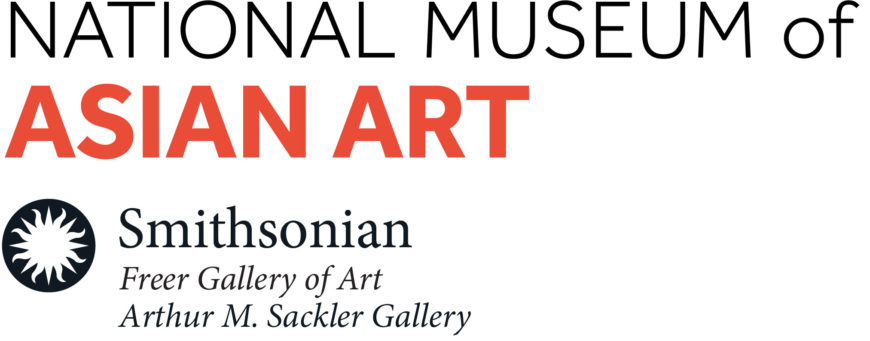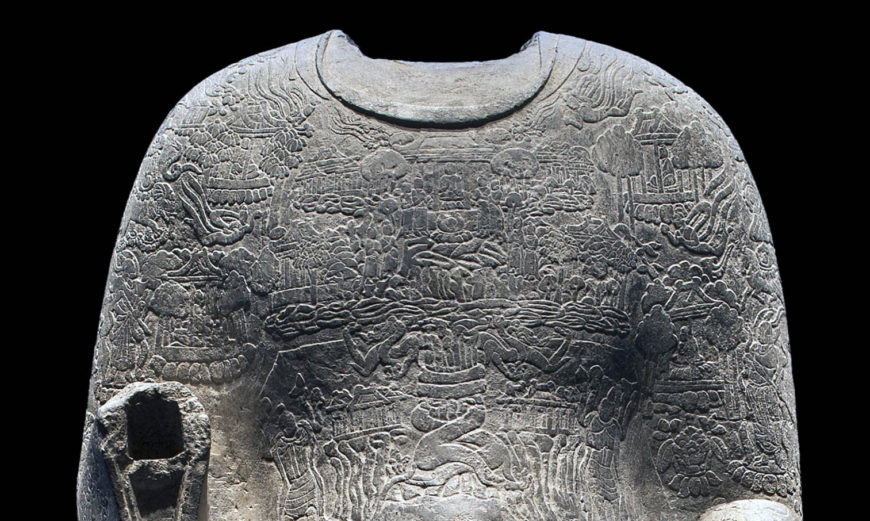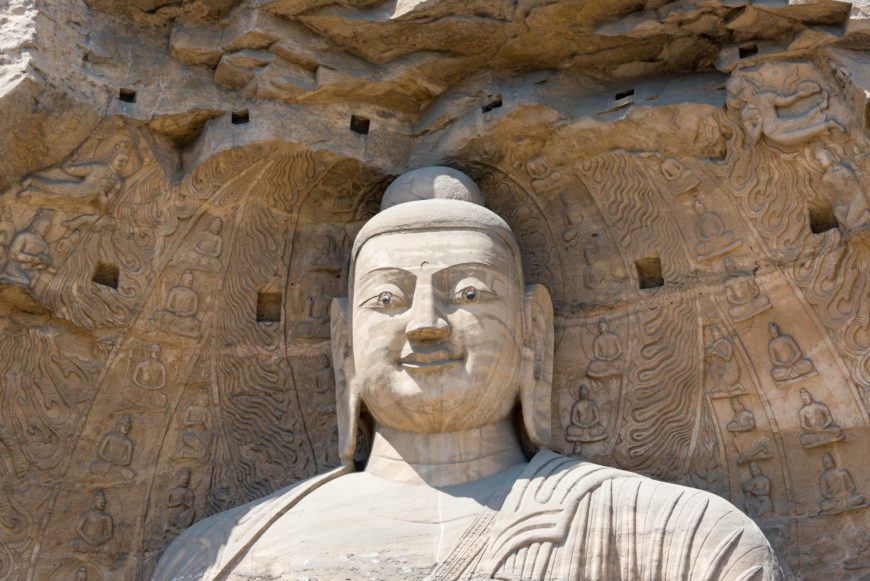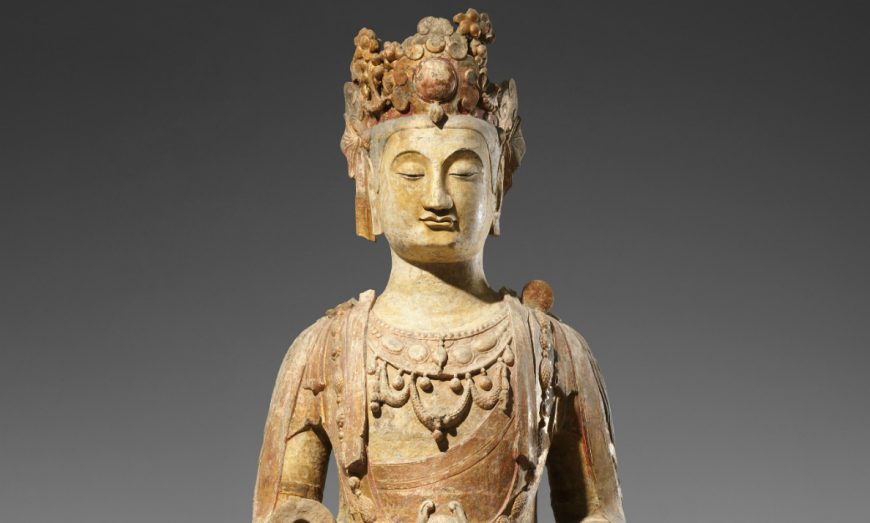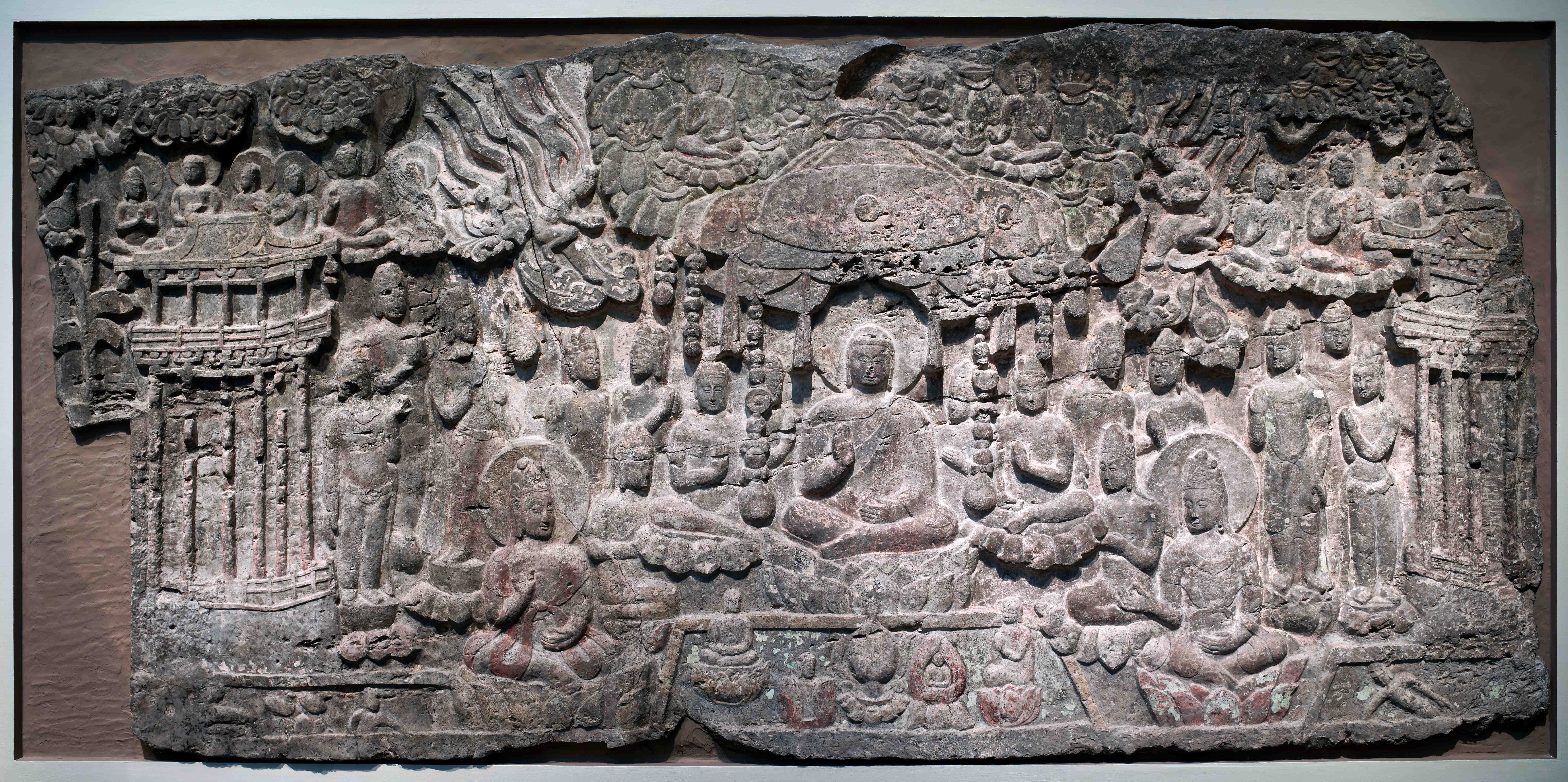
Western Paradise of the Buddha Amitabha, Northern Qi dynasty, 550–577, limestone with traces of pigment, China, Hebei province, Fengfeng, southern Xiangtangshan, Cave 2, 159.3 high x 334.5 cm (Freer Gallery of Art, Smithsonian Institution, Washington, DC: Purchase — Charles Lang Freer Endowment, F1921.2)
A relief from the “Mountain of Echoing Halls”
This large relief is almost eleven feet long. At the center, a Buddha sits under a canopy decorated with strings of large jewels. He raises his right hand to make a teaching or preaching gesture. Seated deva crowd around him.
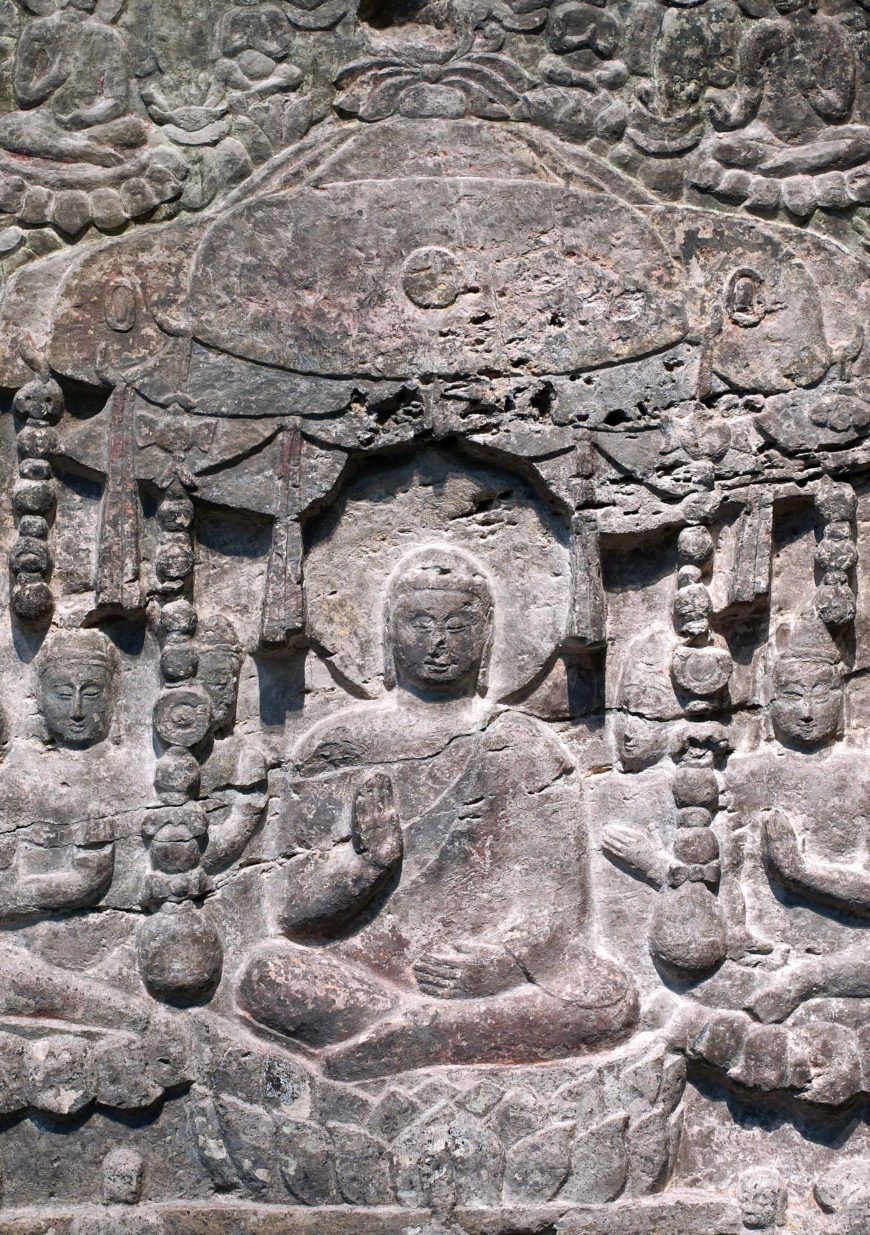
Western Paradise of the Buddha Amitabha, Northern Qi dynasty, 550-577, limestone with traces of pigment, China, Hebei province, Fengfeng, southern Xiangtangshan, Cave 2, 159.3 high x 334.5 cm Freer Gallery of Art, Smithsonian Institution, Washington, DC: Purchase — Charles Lang Freer Endowment, F1921.2)
Above the canopy, more Buddhas and bodhisattvas sit on lotus and are distinguished by the halos around their heads. Other flying divinities and musical instruments float in the sky. One tall lavish building appears at each side of the relief.
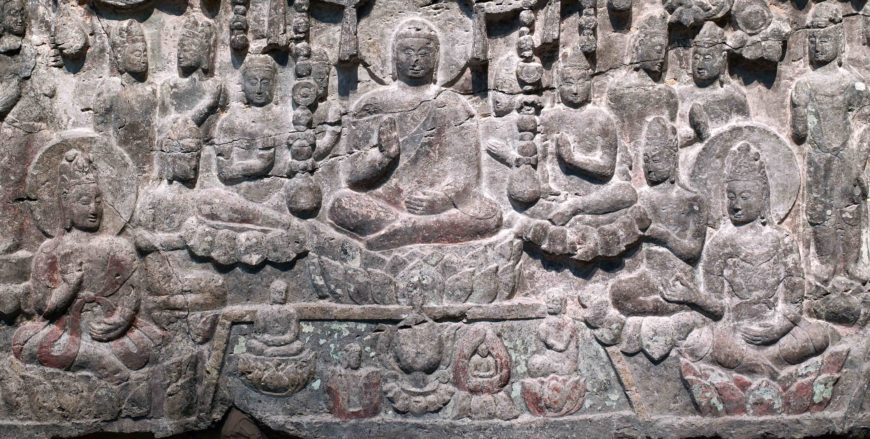
Western Paradise of the Buddha Amitabha, Northern Qi dynasty, 550-577, limestone with traces of pigment, China, Hebei province, Fengfeng, southern Xiangtangshan, Cave 2, 159.3 high x 334.5 cm Freer Gallery of Art, Smithsonian Institution, Washington, DC: Purchase — Charles Lang Freer Endowment, F1921.2)
A rectangular pond, flanked by the bodhisattvas Avalokiteshvara and Mahasthamaprapta, lies in front of the central Buddha. It is the focus of attention of the Buddha and the two principal bodhisattvas. Inside the pond, small childlike figures sit on lotus blossoms or are enclosed inside the flowers. These represent reborn souls, some lotus blossoms are still tightly closed and others are in full bloom.
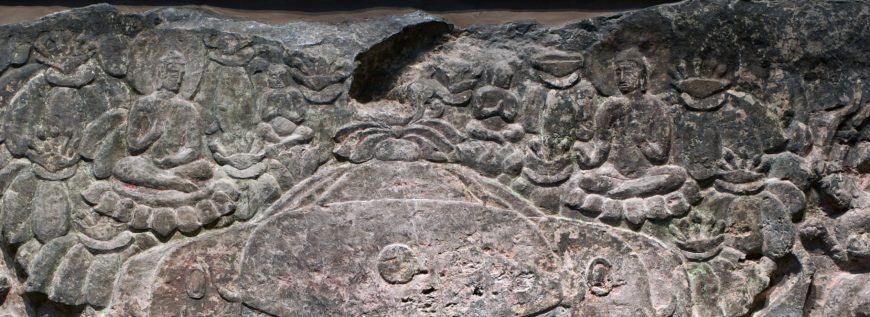
Western Paradise of the Buddha Amitabha, Northern Qi dynasty, 550-577, limestone with traces of pigment, China, Hebei province, Fengfeng, southern Xiangtangshan, Cave 2, 159.3 high x 334.5 cm Freer Gallery of Art, Smithsonian Institution, Washington, DC: Purchase — Charles Lang Freer Endowment, F1921.2)
The Buddha is Amitabha, the Buddha of Infinite Light. He resides in his heavenly realm called the Western Paradise, or Pure Land. Devotees believe that absolute faith in Amitabha empowers a person to be reborn in his paradise. According to the scriptures, the Western Paradise is a land of bliss. People there enjoy peace and plenty. Beautiful music sounds from the sky. Trees grow precious jewels. The relief depicts Amitabha welcoming newly reborn souls who emerge from lotus blossoms. It is believed to be the earliest known illustration of the Western Paradise in Chinese art.
The relief comes from the wall of a cave at Xiangtangshan, literally “Mountain of Echoing Halls,” in Northern China. The Buddhist cave temples of Xiangtangshan are a group of worship halls or shrines carved into the mountains during the sixth century. Created with the financial support of the royal family and officials, the caves represent the power and prestige of the throne and the popularity of Buddhist belief at the time. The relief was originally carved on top of the entrance to Cave 2, facing the main altar of the cave. Sculptures of Amitabha and other divinities also stood on the altar. One would have felt as if entering the heavenly dwelling of the Buddha Amitabha when walking into the cave.
Diving Deeper into Buddhism – Western Paradise
Siddhartha Gautama(sihd-dahr-tuh gaw-tuh-muh) the given name of Shakyamuni, literally “Sage of the Shakya Clan,” the Historical Buddha. He lived in northeastern India sometime after the fifth century BCE., a prince born approximately 2,500 ago, is recognized as the Historical Buddha, or “Awakened One.” His enlightenment freed him from the cycle of rebirth, and his teachings became Buddhism’s foundation. The religion spread with a phenomenal pace. Buddhism reached China around the second century CE and grew into a variety of schools. One of the Buddhist schools that emerged in China—the Pure Land school—focused on Amitabha, the celestial Buddha of Infinite Light. Followers of this school believe that Amitabha took a special vow to create the Western Paradise, or Pure Land (Sukhavati). Those who call upon Amitabha are reborn from lotuses into this heavenly realm where they perpetually practice the dharma. Images of Amitabha and his palace-like monastery are especially popular in China, Korea, and Japan.
Devotional worship to Amitabha and hopes of being reborn in his heavenly dwelling grew quickly in China. Believed to be one of the earliest surviving depictions of Buddhist paradise, the sixth-century relief titled “Western Paradise of the Buddha Amitabha” at the Freer Gallery once appeared above the interior entrance to a Chinese Buddhist cave at Xiangtangshan in Hebei province. Originally painted with striking mineral pigments and gold, it would have been the last thing a worshiper saw before leaving the sacred space.
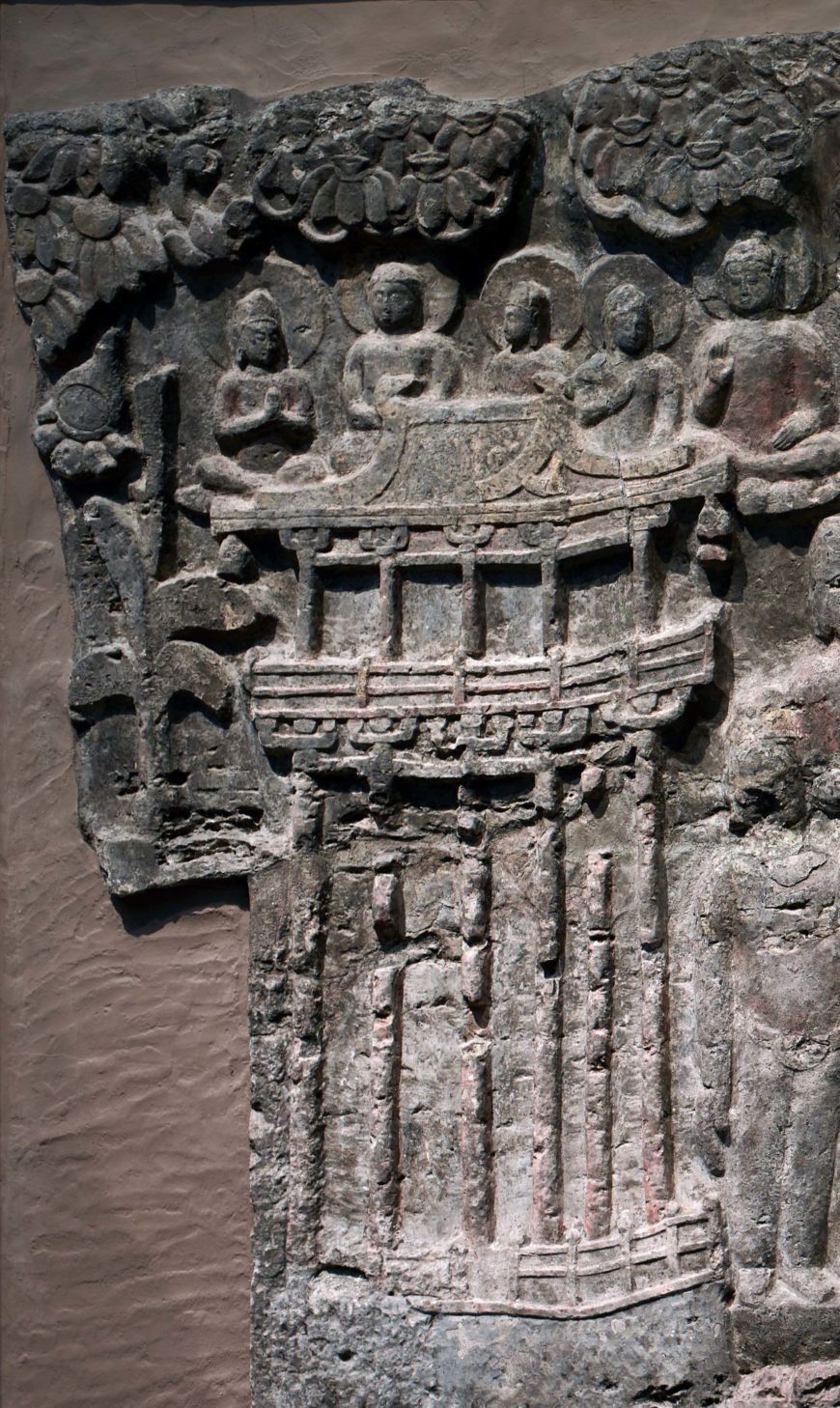
Western Paradise of the Buddha Amitabha, Northern Qi dynasty, 550-577, limestone with traces of pigment, China, Hebei province, Fengfeng, southern Xiangtangshan, Cave 2, 159.3 high x 334.5 cm Freer Gallery of Art, Smithsonian Institution, Washington, DC: Purchase — Charles Lang Freer Endowment, F1921.2)
This monumental limestone carving depicts a heavenly realm brimming with Buddhist deities. Framed by towering pagodas, the roughly symmetrical composition emphasizes the central figures—in particular, Buddha Amitabha (in Chinese, Amituo), who raises his right hand in a gesture of teaching. He sits on a large lotus blossom behind a square pool, alongside which are his two chief attendants, the bodhisattva Avalokiteshvara (Guanyin) and Mahasthamaprapta (Dashizhi). Based on the prominence of these three figures, we know that the setting is Sukhavati, Amitabha’s Western Paradise, or Pure Land. In the pool, lotus blossoms open to reveal the fortunate who are being reborn into this heavenly realm.
This resource was developed for Teaching China with the Smithsonian, made possible by the generous support of the Freeman Foundation


